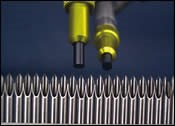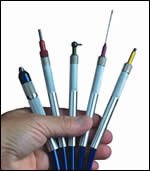Surface Treatment For Medical Parts
Micro-abrasive blasting provides a cost-effective, environmentally friendly solution to surface treatment requirements in a range of medical applications. Though most engineers are familiar with grit, or cabinet, blasting, few know much about its obscure relative, micro-abrasive blasting.
Micro-abrasive blasting provides a cost-effective, environmentally friendly solution to surface treatment requirements in a range of medical applications. Though most engineers are familiar with grit, or cabinet, blasting, few know much about its obscure relative, micro-abrasive blasting.
Within the medical industry, this process has been used to clean oxide and remelt from the side walls of a stent, selectively remove polymers from catheters and guide wires and deburr the heel burr on needles. It can also be used to restore surface finishes to mold cavities and to clean and texture implantable devices including titanium bone screws, prosthetics and cardiac pacemakers.
The micro-abrasive blasting process is a deceptively simple process that involves a patented system to uniformly mix air and abrasive media that is propelled out of a small nozzle tip at high velocity. With a hand piece the size of a pencil, the operator can effectively treat fragile parts or a localized area on a larger component. The key to this process is the ability to carefully control the amount of abrasive in the mixture. Also, different from cabinet blasting, a tight tolerance is required on the range of micron-sized media.
Applying The Technology
Micro-abrasive blasting is a technology that is increasingly sought out by medical device manufacturers to improve production quality and efficiency. On many surgical tools and instruments, a sharp edge is critical to the device performance. The grinding process to achieve these edges can result in fine burrs remaining on the tip of the blade. Using a soft abrasive such as sodium bicarbonate, micro-abrasive blasting removes the burrs without damaging the quality of the cutting surface. As a secondary process, micro-abrasive blasting can also hone the edge to improve the tool durability.
Medical implant devices fabricated by laser machining and stamping of nickel titanium alloys often contain minute defects and blemishes as a result of the manufacturing process. Remelt from strut junctions occurs when the residual laser slag re-bonds itself to the device. Oxide layers and pulse marks are generated in the laser machining process causing sharp edges and burrs to develop. These all impair the ability of electro-polishing to create the desired finish. Micro-abrasive blasting effectively removes these residues. It also imparts a small radius, reducing the sharpness of the strut’s edge. By removing these imperfections, the performance, as well as the life span of the device, is significantly improved.
This process can also be used to selectively treat sections of dental implants. The post of a dental implant is similar to a bone screw. It is critical that the post be securely anchored into the gum. This can be accomplished by roughening the surface of the threaded portion, which promotes tissue in-growth. The region of the implant that remains in the soft tissue, however, must remain very smooth to avoid bacterial growth. Micro-abrasive blasting gives the operator the control necessary to selectively treat regions of the device.
The ability of micro-abrasive blasting to target a small section also makes it an ideal process in the manufacturing of needles. After grinding, the tip of the needle is sharp all around the edges. To prevent it from cutting a core, which could cause blockage as well as increase healing time, micro-blasting is used to radius the heel of the needle tip. It is then used to roughen the butt-end of the needle to improve bond adhesion. Aluminum oxide and glass bead are often used to accomplish this.
Systems Approach
To fit a variety of finishing applications, Comco Inc. offers three lines of micro-abrasive blasters. The MicroBlaster, available in both single- and dual-tank models, is used in both manual and semi-automated applications. This lightweight blasting unit is small enough to fit on a workbench. The DirectFlo series offers increased power and powder capacity, enabling the use of larger nozzles or multiple nozzles in high-volume environments. The PowerFlo series combines the features of the DirectFlo with an internal microprocessor for integration into automatic systems.
Comco combines each of these micro-abrasive blasting systems with a set of components to provide a well-rounded surface treatment solution. The components include a workstation for containing the abrasive stream as it is propelled, an air dryer to prevent moist air from causing nozzle stoppage, a duct collector and a range of micron-sized media or powder to be used as the abrasive element. The workstation not only captures the abrasive particles, but also provides the operator with a highly visible work area. A desiccant bead or membrane-style air dryer is necessary to remove moisture, maintaining a dew point of -25° F. The dust collector component is specifically designed to handle micron-sized particles, maintaining good operator visibility and a clean workstation.
The distinctive characteristics of each type of powder influence the action of the abrading process. For the majority of medical implant device applications, either 17.5- or 25-micron aluminum oxide is the abrasive of choice. In certain circumstances where specific electro-polishing issues must be addressed, 20-micron silicon carbide is used. Other abrasives commonly used in micro-abrasive blasting include sodium bicarbonate, glass bead, crushed glass, plastic media and walnut shell.
As the elements of a micro-abrasive blasting system come together, they provide a versatile surface finishing solution for medical device manufacturers and others who require a high degree of accuracy and repeatability.
Related Content
The Value of Swiss-Types Milling Rectangular Medical Parts
High-speed spindle technology was key to effective milling of small cardiac monitoring components complete on a CNC sliding-headstock machine platform instead of running them across two mills.
Read MoreMeeting Stringent Cleaning Goals With Modular Ultrasonic System
A knee implant manufacturer implements an advanced cleaning system that meets its tight cleaning requirements, including documenting, validating and tracing the entire cleaning process.
Read MoreWhere Micro-Laser Machining Is the Focus
A company that was once a consulting firm has become a successful micro-laser machine shop producing complex parts and features that most traditional CNC shops cannot machine.
Read MoreThe Value of Mass Finishing, Shot Blasting for Aerospace and Medical Applications
The choice between mass finishing and shot blasting for CNC-machined parts depends on the specific requirements of the application.
Read MoreRead Next
Getting More Bang For Your Deburring Buck
Today, customers demand parts that are burr-free, which would suggest aggressive deburring. At the same time, they want parts that are free of scratches and dings, which calls for gentle processing. There is a non-conventional deburring process that not only completely removes burrs from even difficult-to-reach part areas, but also leaves machined features and surface finishes intact and parts free of nicks and scratches. The process is called thermal deburring.
Read MoreRobotic Deburring Provides Flexible Alternative
The consistent performance and radial compliance of this device is making companies re-evaluate their manual deburring operations.
Read MoreA Tooling Workshop Worth a Visit
Marubeni Citizen-Cincom’s tooling and accessory workshop offers a chance to learn more about ancillary devices that can boost machining efficiency and capability.
Read More

















.jpg;maxWidth=300;quality=90)








